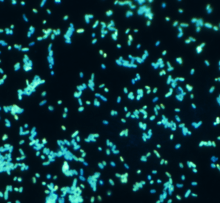Nitratiruptor
Nitratiruptor sp. (strain SB155-2) is a genus of deep sea gram-negative ε-proteobacteria isolated from Iheya North Hydrothermal field in Okinawa Trough (Japan).[3] This rod-shaped microorganism (0.5 x 1.5 µm) grows chemolithoautotrophically in a wide variety of electron donors and acceptors (i.e. sulfur, hydrogen, oxygen and nitrate) in absence of light and oxygen. It is also a thermophilic group capable of growing within the range of 37–65 °C with the optimal at 55 °C.
| Nitratiruptor | |
|---|---|
| Scientific classification | |
| Kingdom: | Bacteria |
| Phylum: | |
| Class: | |
| Order: | |
| Family: | unclassified Epsilonproteobacteria[1] |
| Genus: | Nitratiruptor[1] Nakagawa et al. 2005[2] |
| Type species | |
| Nitratiruptor tergarcus[2] | |
| Species | |
|
N. tergarcus[2] | |
Genetic features

Nitratiruptor sp. genome is composed by a single circular chromosome of 1,877,931 bp with the GC content content of 43.8% and 39.7%.[4] Due to the geochemical variability in the deep-sea hydrothermal vents, Nitratiruptor sp. displays a metabolic versatility to adapt to this hostile environments which includes sharp gradients in energy sources, electron acceptors or carbon sources. For instance, due the metal-rich fluids characterizing this areas, a total of 17 genes related with transports systems and detoxification mechanisms of heavy metals (including As, Cd and Cu) were described. Despite this not being a pathogenic bacterium, it possess some virulence genes (including virulence factor mviN, hemolysin or N-linked glycosylation gene cluster) which provide insights into the origins of virulence in their pathogenic relatives, Helicobacter and Campylobacter species.[5]
References
- "Nitratiruptor tergarcus". www.uniprot.org.
- "Nitratiruptor". www.bacterio.net.
- Nakagawa, Satoshi; Takai, Ken; Inagaki, Fumio; Horikoshi, Koki; Sako, Yoshihiko (2005). "Nitratiruptor tergarcus gen. nov., sp. nov. and Nitratifractor salsuginis gen. nov., sp. nov., nitrate-reducing chemolithoautotrophs of the ε-Proteobacteria isolated from a deep-sea hydrothermal system in the Mid-Okinawa Trough". International Journal of Systematic and Evolutionary Microbiology. 55 (2): 925–933. doi:10.1099/ijs.0.63480-0.
- "PATRIC". www.patricbrc.org. Retrieved 2019-06-07.
- Horikoshi, Koki; Takai, Ken; Reysenbach, Anna-Louise; Shimamura, Shigeru; Takaki, Yoshihiro; Nakagawa, Satoshi (2007-07-17). "Deep-sea vent ε-proteobacterial genomes provide insights into emergence of pathogens". Proceedings of the National Academy of Sciences. 104 (29): 12146–12150. doi:10.1073/pnas.0700687104. ISSN 0027-8424. PMC 1907315. PMID 17615243.